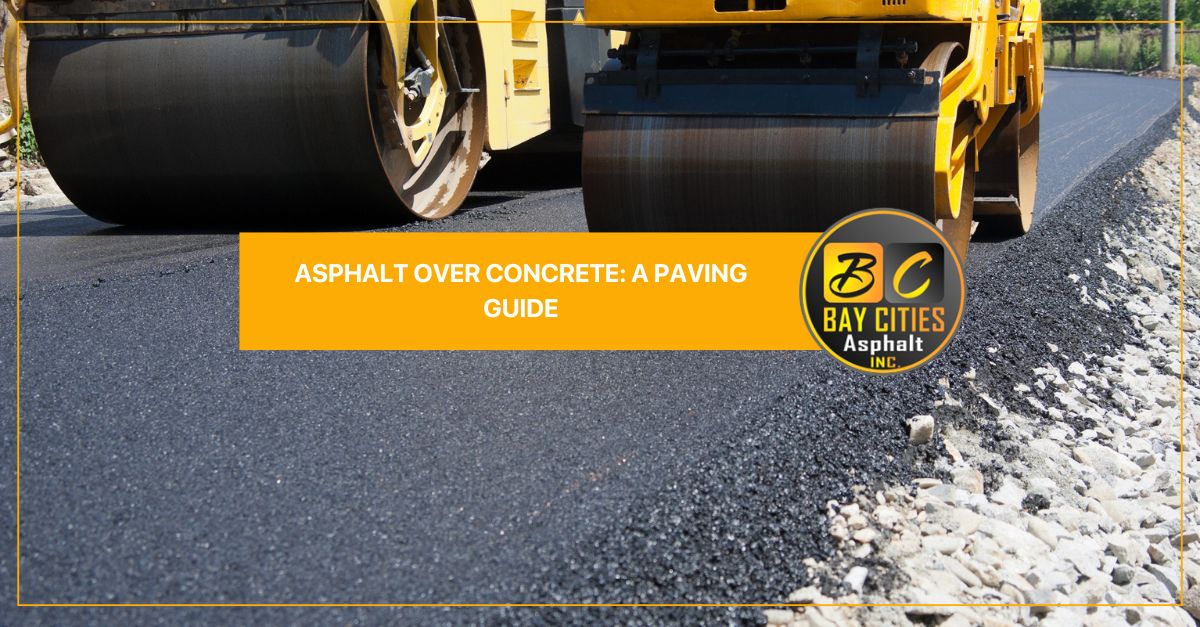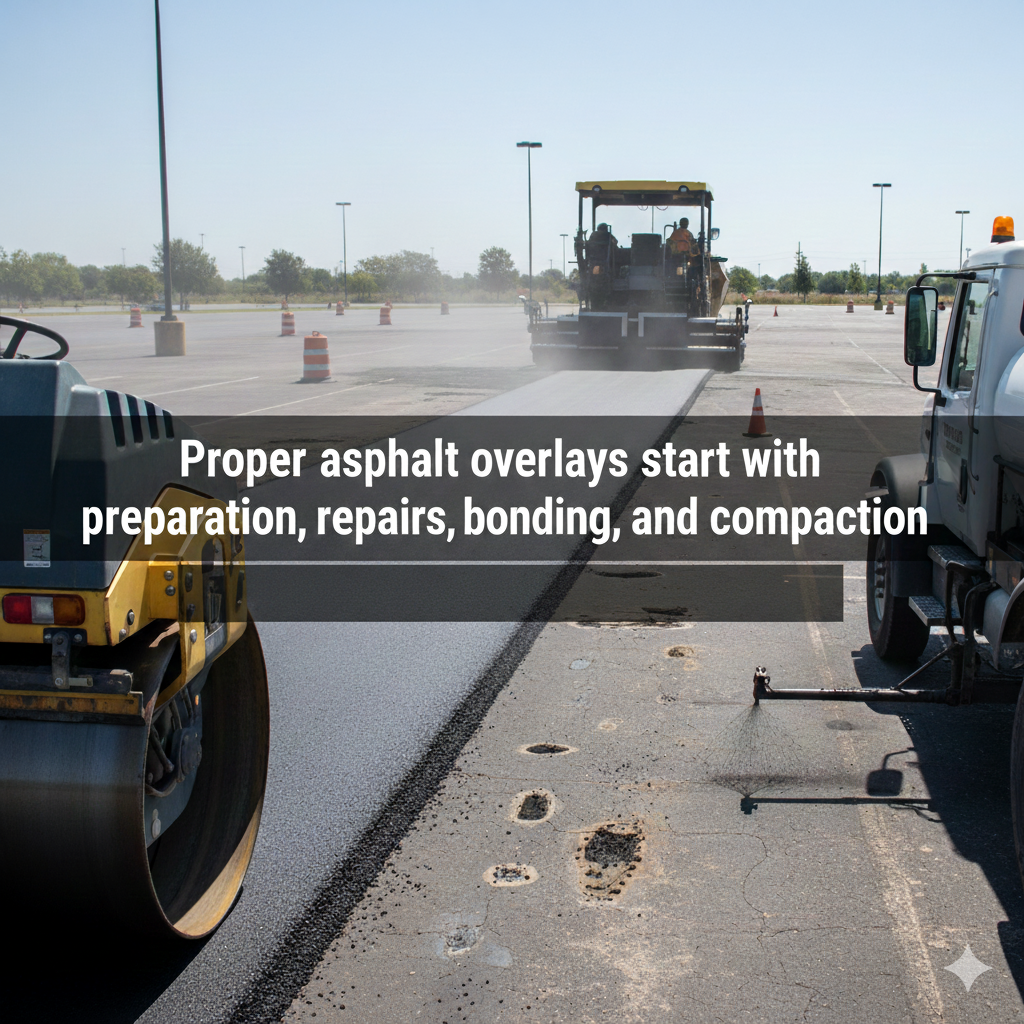
You have a concrete driveway, patio, or parking lot that’s seen better days. It’s cracked, stained, and uneven, and you’re ready for a change. Ripping it all out and starting from scratch sounds expensive and time-consuming. That’s when you might wonder: can I just put asphalt over concrete on the existing surface?
The short answer is yes, you can. An asphalt overlay on a concrete surface is a common practice that can save you time and money. However, it’s not a one-size-fits-all solution. The success of this method depends heavily on the condition of the underlying concrete, proper preparation, and professional installation.
This guide will walk you through the pros and cons of paving asphalt over concrete, explain the step-by-step process, and help you decide if it’s the right choice for your project.

The Good and The Bad: Pros and Cons of Asphalt Overlays
Applying an asphalt overlay seems like a straightforward fix, but it’s important to weigh the benefits against the potential drawbacks before making a decision.
Advantages of an Asphalt Overlay
- Cost-Effective: The biggest advantage is cost savings. By using the existing concrete as a base, you avoid the significant expenses associated with demolition, removal, and disposal of the old material. This can reduce the total project cost substantially.
- Faster Installation: The process is much quicker than a full replacement. Since you’re skipping the demolition phase, your new surface can be ready in a fraction of the time.
- Durability: When done correctly, an asphalt overlay creates a strong, flexible surface. Asphalt is less prone to cracking from temperature changes compared to concrete and can handle heavy traffic well.
- Aesthetic Appeal: A fresh layer of blacktop provides a smooth, clean, and uniform appearance, instantly boosting your property’s curb appeal.
Disadvantages to Consider
- Reflective Cracking: This is the primary risk. Any cracks or joints in the concrete base can eventually transfer up through the new asphalt layer, a phenomenon known as reflective cracking. This happens because the slabs of concrete underneath can shift independently, stressing the asphalt on top.
- Drainage Issues: An overlay will raise the surface height. This can interfere with existing drainage patterns, potentially causing water to pool or flow toward buildings. Proper grading and planning are crucial to prevent this.
- Not a Permanent Fix for Bad Concrete: If the underlying concrete is severely damaged, unstable, or has significant structural issues, an overlay is merely a temporary bandage. The problems will reappear, and you’ll end up paying for repairs and eventually a full replacement.
How Is an Asphalt Overlay Installed?
A successful asphalt overlay requires meticulous preparation. Otherwise, simply pouring asphalt over dirty, cracked concrete is a recipe for failure. To understand why, here’s what a professional process looks like:
Step 1: Thorough Cleaning and Inspection
First, the concrete surface must be completely clean. Professionals use power washers and brooms to remove all dirt, debris, oil stains, and vegetation. Afterward, they conduct a detailed inspection to assess the condition of the concrete, identifying cracks, spalls, and unstable sections.
Step 2: Repairing the Concrete Base
This is the most critical step. All significant cracks in the concrete must be filled with a specialized sealant. Any unstable or badly damaged sections of concrete should be removed and patched. If the base isn’t solid, the overlay won’t last. The goal is to create a stable, uniform foundation for the asphalt.
Step 3: Applying a Tack Coat
Once the concrete is clean and repaired, a tack coat (or bond coat) is applied. This is a thin layer of liquid asphalt emulsion that acts as a glue, ensuring the new asphalt layer adheres properly to the concrete base. A strong bond is essential to prevent slippage and extend the life of the overlay.
Step 4: Laying the Asphalt
Next, hot-mix asphalt is laid over the prepared surface using a paving machine. The asphalt is typically applied in a layer that is 1.5 to 3 inches thick, depending on the project’s needs and the condition of the base. The crew ensures the asphalt is spread evenly and graded correctly to maintain proper drainage.
Step 5: Compaction
Finally, a heavy roller is used to compact the new asphalt. Compaction is vital for creating a dense, durable surface that is resistant to water penetration and traffic wear. Multiple passes with the roller ensure the asphalt achieves the right density and a smooth finish.

Petromat Overlays: An Enhanced Solution
For added protection against reflective cracking, many paving experts recommend a petromat overlay. Here at Bay Cities Asphalt, it’s one of the solutions we often suggest for projects requiring extra durability.
A petromat is a nonwoven, petroleum-based fabric that is laid down over the existing concrete after the tack coat is applied. Another layer of tack coat is then applied over the fabric before the hot-mix asphalt is installed.
This fabric creates a powerful waterproof barrier and a stress-absorbing interlayer between the old concrete and the new asphalt. It helps to isolate the new surface from the movements of the concrete slabs below, significantly reducing the likelihood of reflective cracking and extending the lifespan of your pavement.
Is an Asphalt Overlay Right for Your Project?
An asphalt overlay is an excellent option if your concrete base is in relatively good condition. It works best when the concrete has only minor surface-level cracks and is structurally sound.
However, you should avoid an overlay if your concrete has:
- Deep, wide cracks (wider than half an inch).
- Significant upheaval or sinking (uneven slabs).
- Widespread “alligator” cracking (interconnecting cracks forming a web).
- Poor underlying soil support, causing the concrete to shift.
In these cases, the money spent on an overlay would be wasted, as the same problems will quickly reappear. A full demolition and replacement would be the more cost-effective solution in the long run.
Make the Right Paving Choice
Paving asphalt over concrete can be a smart, budget-friendly way to get a brand-new surface without the headache of a full replacement. When the underlying concrete is sound and the preparation is thorough, an asphalt overlay provides a durable and attractive result that will last for years.
The key to success is an honest assessment of your existing concrete and professional installation. An experienced paving contractor can evaluate your surface and advise whether an overlay is a viable option or if a different approach is needed. By investing in proper preparation and quality materials, you can ensure your new asphalt surface stands the test of time.
